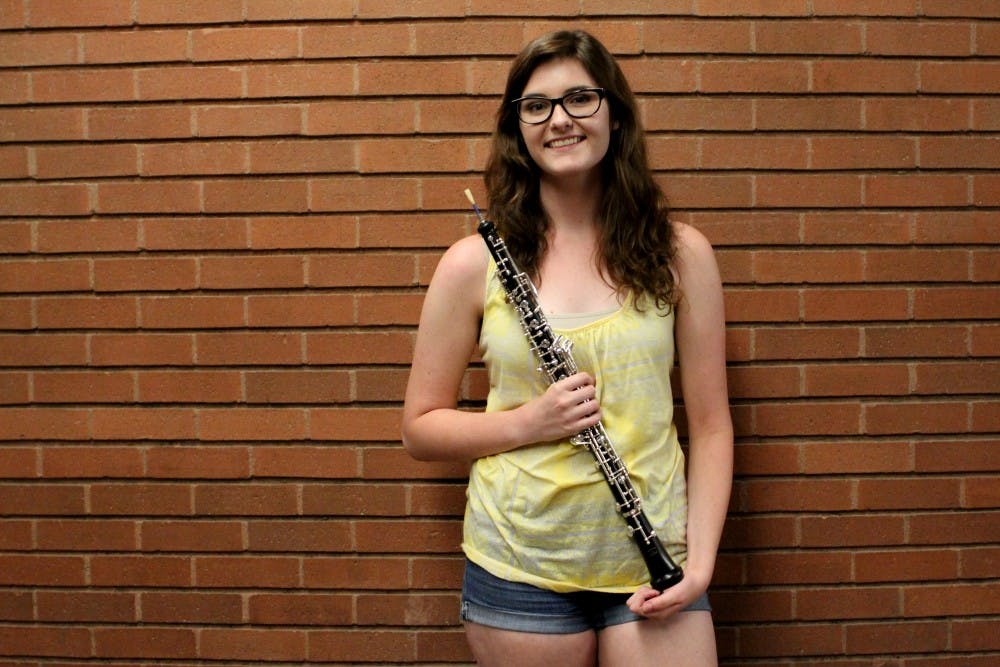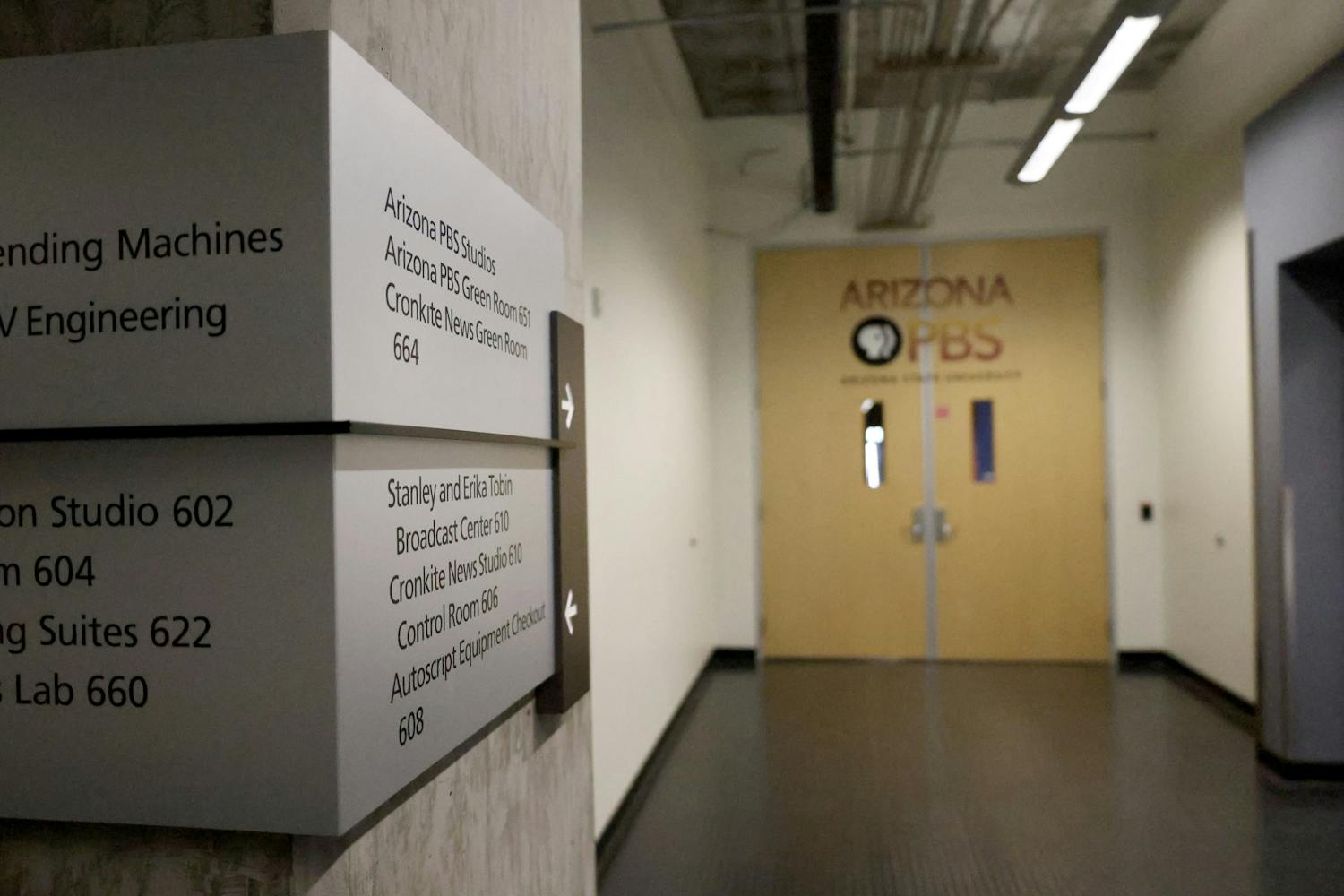 Material science and music performance freshmen Alexis Mitchell poses for the camera at the ASU School of Music. She plans to invent a synthetic oboe reed to help reduce the cost of current reeds that are temporary. (Photo by Diana Lustig)
Material science and music performance freshmen Alexis Mitchell poses for the camera at the ASU School of Music. She plans to invent a synthetic oboe reed to help reduce the cost of current reeds that are temporary. (Photo by Diana Lustig)Music performance and material science and engineering freshman Alexis Mitchell plans to use her future years at ASU to invent a synthetic oboe reed, something that has never been successfully done.
Combining her passion for music and her love of science and math, Mitchell aims to create a reed that would give oboists much more time and save them money.
“There aren’t many oboists out there that have a science background or a math background,” she said. “And there aren’t many scientists or engineers or mathematicians that have a reason to really get involved in the oboe world, because it’s so specific.”
A reed vibrates when air blows against it. It produces sound in instruments such as the oboe or clarinet.
Mitchell decided to pursue science after her best friend Christopher Kantzos, a material science and engineering freshman, convinced her to take AP Chemistry in high school.
She said she had always wanted to pursue another degree on top of music performance in oboe, but she didn’t quite know what she wanted to do. After taking chemistry, she decided she wanted to work more in that area.
“I wanted to figure out what major I could pursue that would allow me to do both chemistry and math," she said. "So I found out that some type of engineering would work really well."
After visiting ASU and learning more about the material science program, she knew she wanted to study that alongside music.
She brought up the idea to her her oboe teacher Martin Schuring, who teaches at ASU, about a year ago. He told her it would be great to form a bridge between the two studies.
“I didn’t know of anyone who was equally an expert as a musician and as a scientist, and that she could make a contribution in that way,” he said. “So I think that idea stuck with her and has become now something kind of concrete.”
Following this conversation, Mitchell said she started to formulate ideas that would involve both science and the oboe.
“The one thing that really stuck out to me was the idea of creating other types of reeds in the aspect of using a different material than the actual cane,” she said.
Cane, a material with wood-like texture, is used to make reeds. Depending on which instrument it's used on, the cane is manipulated to form a certain shape.
The oboe is a double-reed instrument, Mitchell said, so it requires two pieces of cane that are bound together at the base.
Making reeds is a time-consuming process. Mitchell said she spends a few hours a day making reeds, and she goes through about three reeds every week.
Making reeds can be a frustrating procedure, Mitchell said.
“It’s a very long process, and it’s something you have to be paying a lot of attention when you’re doing,” she said.
Mitchell said she wants to shorten the time it takes to make reeds and invent an oboe reed that would, in theory, last forever.
“The thing is, musicians in general have so many costs they have to pay on a regular basis,” she said. “There are so many issues with the instruments as far as having to maintain them all the time.”
Mitchell and Kantzos, who has been helping her with the process, compared the cost of making a synthetic reed to the cost of continuously buying new ones.
“We’ve been looking into whether it would cost more to continually buy reeds or to have one really good reed,” he said.
To achieve this, they calculated the cost of buying reeds over the course of a year. They figured oboists use more than 100 reeds a year, and at $20 a reed, it would cost $2,000.
Kantzos said a synthetic reed would be much cheaper.
Although Mitchell hasn’t identified the specific polymers she might use, she knows the materials she does use must resemble the structure and fibers of cane.
“The fibers are really going to affect the sound production,” she said.
Schuring said although professional players probably would continue making their own reeds, it would help students and those who play for recreation.
“That would remove a huge time commitment and worry from their life where they could just enjoy playing the instrument,” he said.
A synthetic reed would need two qualities: consistency and durability. To do this, Mitchell would have to find the right material and fabricate it to form the reed, Schuring said.
“And that’s where you need a musician to be able to evaluate those things,” he said.
Mitchell said she plans on working on her synthetic reed idea for her honors thesis. As a student in Barrett, the Honors College, she is required to create a thesis in order to graduate in the college.
Even if she doesn’t finish the reed during her undergraduate degrees, she said she plans on pursuing master’s degrees in both areas, and she will continue her research during that time.
She has started the research process and has shared her ideas with Kantzos' father, who is a material scientist. Soon she would like to start working with a professor.
“I do really think that I’ll be able to gain a lot of understanding and a lot of help and advice and guidance from the material professors, who are absolutely amazing,” she said.
Throughout the course of her freshman year, she plans on gathering information and research. She said she would eventually like to branch out into other areas of music and better instruments for other musicians.
“I want to pursue music, because it allows me to create new things artistically and with expression, and with material science and engineering, I’m able to create new things mathematically and scientifically,” she said. “I guess I’m kind of centered around the idea of making new things and exploring new things that haven’t been discovered yet.”
Reach the reporter at savannah.harrelson@asu.edu or follow her on Twitter @savannahleeh




